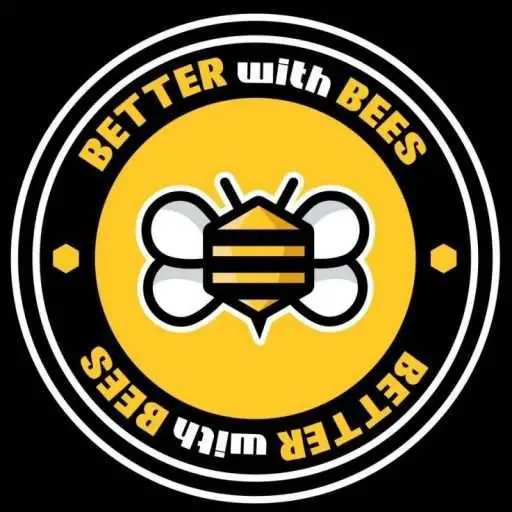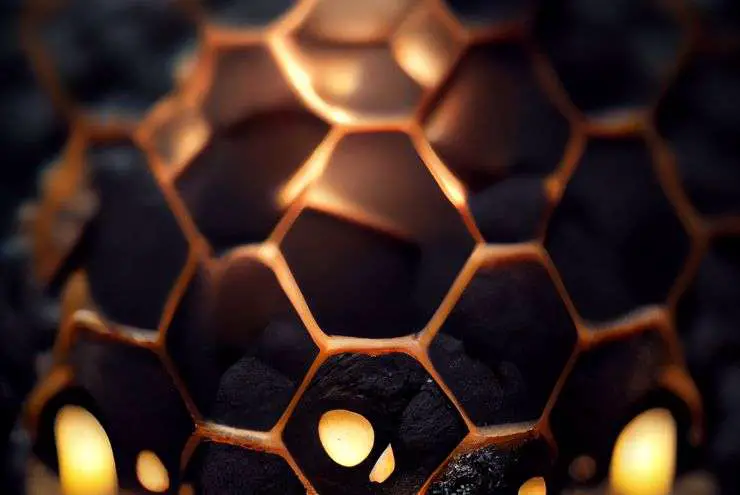Imagine for a minute, a fresh new home, plush golden carpet, and untouched. Then, an entire class of 3rd graders trample in after playing outside. This is repeated over and over again, and there’s nobody who is ever designated to clean the debris from the floors.
The carpet isn’t looking so fresh anymore, is it? That’s what happens with honeycombs. They start off, naturally, barely touched and clean.
Over time, bees come in after a hard day’s work, with their little bee feet, and start to track in some dirt. (Bees are notorious for not wiping their feet before entering their houses!) So, what makes a black honey comb? It’s not just dirty bee feet!
What Does Dark Honeycomb Mean?
Black honeycomb, also known as dark honeycomb, is nothing to be alarmed about. While it may be unsettling the first time you notice it, it’s usually a clear indicator that the honeycomb is performing optimally!
Dark honeycomb often means that brood has come through that part of the beehive. Bee brood is the larvae, eggs, and pupae of bees. Brood cells will naturally be darker (leading to black honeycombs) than what is known as virgin honeycomb.
Virgin honeycomb is where honey is stored which is separate from the brood combs. This honey-storing, virgin comb will often remain golden, and retain the color of what you normally associate with honey. But, not always.
Functions of Black Honeycombs
Bees are the absolute masters at designing a well-operating machine when it comes to their beehive. After all, these pollinators live to make honey – it only makes sense they perfect their factories which also act as their homes.
There is a lot that goes into what a beehive is made out of. Because of their engineering brilliance, they can also store honey in combs which once housed brood.
Honey is not only stored in virgin homes but also kept in dark honeycombs once they are no longer being used for brood. This allows honeycombs to be truly multi-purpose. No comb is being wasted for these bees.
Don’t worry, we’ll examine the difference between combs used for storing honey and brood combs.
Black Brood Comb vs. Black Honey Comb
It’s completely normal to have black brood combs and black honeycombs. However, there are some variations when it comes to what makes a brood comb black versus what makes a honey comb black. Let’s buzz into it.
Black Brood Comb
Brood combs take in a lot of debris and materials! Like the messy 3rd graders, it is nearly impossible to have a pristine comb if it is taking in so much traffic, and brood combs don’t just get dirty from bee feet.
Dark honeycomb is the result of a buildup of bee necessities like propolis, pollen, and cocoons. While honey cells also contain propolis and pollen, they do not have cocoons – which has a lot to do with why virgin honey combs aren’t observed as black honeycombs.
Brood cells will have higher traffic when compared to honey cells. Bees return to the brood cells frequently to feed the growing bees (larvae).
When honey is in a honey cell, the bee will simply move on to another. That’s quite the difference. Picture how messy a playroom is compared to an office. The playroom will have a lot more activity whereas your office will be pretty well maintained.
Black Honey Comb
If you’re new to beekeeping, you may find a black honey comb alarming. There may be a fear of parasites or something else gone terribly wrong, but black honeycombs are often a positive thing!
Bees recycle their combs as long as they are in adequate shape. This makes it possible for a beehive to thrive for years! There is a benefit for bees to use retired brood combs for honey, and it has to do with just how much space there is.
When bees use empty brood combs for honey, they are making it to where larger combs can be used to store brood. The reason this is important is because brood cells get smaller over time compared to honey combs.
With using brood cells for honey, it opens the door for brood to be placed in the bigger honey cells! Bees from smaller brood cells tend to grow up smaller, and that’s not ideal. It’s best if the brood cells are larger to ensure proper growth of the bee.
Dark Honeycomb Benefits
Believe it or not, dark honeycombs don’t just act as a clear marker for a healthy honeycomb, but they may also have more health benefits than your standard, golden honeycombs.
You may think that harvesting brood honeycomb is a waste of time. After all, who wants to eat honey that once housed larvae and the subsequent debris from doing so?
Well, there are parts all around the world that believe that honey from black honeycombs offer more health benefits than honey from virgin honeycombs.
Health Benefits
Black honeycombs or dark honeycombs once used for brood rearing are said to contain beneficial enzymes that aren’t found from traditional honeycombs.
With that being said, there is certainly a different taste when it comes to these two types of honey. But, it’s worth a shot to try it out for yourself!
When Black Honeycombs May Cause a Concern
While there are many benefits of black honey comb, there comes a time when it can do more harm than good. As you now know, dark honeycombs are the buildup of debris, propolis, pollen, and cocoons.
While this is perfectly healthy and natural, too much buildup can prove to be problematic. Pesticides and disease can be present in black honeycombs.
Pesticides
Over time, the dark honeycomb will collect products other than the natural byproducts and materials from bees.
Pesticides, undoubtedly and unfortunately, are brought to the hive by bees, and while a small quantity doesn’t cause too much damage – a buildup could cause serious problems for what appears to be a black bee hive.
Disease
It’s not just the accumulation of pesticides that acts as a possible problem, but the pile-up of bee products is more likely to breed something other than bee diseases. Diseases are much more likely to occur in black bee hives if they build up too much external products. These common diseases are EFP, AFM, and Nosema. However, there are ways to reduce this threat of disease.
So, what can you do to ensure you have a healthy, black bee hive?
Healthy Black Bee Hives
You may have heard of the “three-year-old brood comb.” There is a reason it’s a rule of thumb to change out brood combs at least every three years – to prevent the diseases we discussed before.
Changing out brood combs is an essential part of beekeeping. Bringing in new comb will allow bees to continue thriving without much work from you!
There are varying methods when it comes to changing out your brood honeycomb, but replacing it with a prepared drawn comb and the “Bailey Comb” method seems to be the least problematic ways of going about this.
The Rundown
There is certainly no cause for alarm if you notice black honeycomb! This is a natural result of brood rearing and all that goes along with it – debris, propolis, cocoons, and more. However, it’s important to keep up with maintenance.
You should be sure to change out the brood comb every three years or so to prevent it from causing disease and the buildup of parasites in the beehive. Otherwise, relish in the fact your beehive is performing at its very best!
FAQ
Most likely, your honey comb is black because it has a buildup of products like cocoons, propolis, and pollen. These products are necessary for brood rearing in the beehive. If you notice black honeycomb, keep in mind this is usually a good sign!
Leave it alone, harvest the honey, or change out the comb. Black honeycomb is the natural result of brooding, so its best to leave your black honeycomb as it is. Once the black honeycomb is no longer used as brood cells, bees oftentimes store honey there. You can still harvest this honey, and some believe it offers more health benefits than other honeycombs. Lastly, you want to make sure you are changing out your black honeycomb at least every three years to ensure it stays free of disease and any build-up of pesticides.

